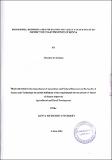| dc.description.abstract | Cassava is ranked second after maize in importance as a food crop and second as root crop after Irish potatoes, in Kenya. The crop is grown throughout Kenya and utilization is mostly through roasting and boiling of fresh roots for consumption. Processing and value addition for the crop is minimal. The study undertook to evaluate dry, wet and traditional cassava processing methods for efficiency in nutrient recovery. Harvesting of roots for processing was done while ensuring minimal damage and subsequently peeling in water. For the traditional method cassava was sliced in to 9:5:2 cm cubes using knives. For the modern processing chipping was done by a chipper and chips divided into halves of 4kg each. The 1st half was processed by wet method and the 2°d half by dry method. Sampling of dried chips from each processing method was done in triplicates. The samples were analyzed for calcium and phosphorus content and thereafter milled and blended with wheat. The blends with cassava levels of 0%, 25%, 50% 75% and I 00% were used to make mahamri and chapati. The products were then tested for acceptability by 30 panelists on the basis of colour, taste, aroma and texture using a 5 point ordinal scale. Results showed more phosphorus and calcium were recovered from varieties - Karembo and Tajirika using dry method. All blends produced chapati and mahamri with mean scores of <2 (liked) for taste and aroma. However the blends that had 75 -100% cassava levels, were ranked lower (> 3). Higher levels of cassava >50% resulted to poor leavening in mahamri. It also resulted to poor moulding qualities in chapatti. The study therefore concluded that dry method is efficient for optimal nutrient recovery. In addition, in order to get acceptable organoleptic attributes in mahamri and chapatti, cassava should be blended with wheat flour at levels of 50% and below. | en_US |

